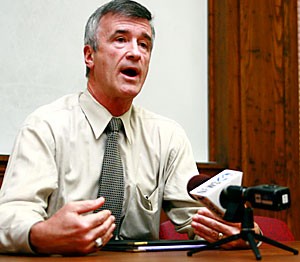President Robert Shelton released a tuition proposal yesterday that will increase tuition for residents by 6.5 percent and nonresidents by 8.5 percent for the 2007- 2008 school year.
The increases would raise undergraduate resident tuition to $4,894, nonresident undergraduate tuition to $16,058, resident graduate tuition to $5,623 and nonresident graduate tuition to $16,351 if the proposal is approved by the Arizona Board of Regents Nov. 30.
Following suit, tuition will also increase for students of UA South and the College of Medicine both here and in Phoenix.
“”This is either the second-lowest tuition proposal in history or the fifth-highest, depending on how you look at it,”” Shelton said.
In the next three years, tuition remission for graduate students involved in research should be at 100 percent – a figure he said he hopes will increase competition and further establish the UA as a leading research institution, Shelton said.
Graduate and Professional Student Council
This is either the second-lowest tuition proposal in history or the fifth-highest, depending on how you look at it.
– Robert Shelton,UA president
President Paul Thorn said he is glad to see that proposed tuition increases are the same in percentage for both undergraduate and graduate students.
“”Obviously, I’d like to see a lower increase, but this is the lowest a tuition increase for resident graduate students has been in the past four years,”” Thorn said.
Differentiating from the past, Shelton said the UA College of Medicine will take part in an “”airplane model,”” that will systematically increase tuition of medical school students depending on their year at both UA College of Medicine campuses in Tucson and Phoenix.
According to the proposed tuition plan, tuition would increase next year by 4.2 percent for the 2008 graduating class, 5.4 percent for the class of 2009, 6.8 percent for the class of 2010 and by 10.9 percent for the class of 2011.
The method comes as a way to give students predictable tuition costs, said Philip Malan, vice dean for academic affairs in the College of Medicine.
“”Medical school tuition is increasing all over the country,”” Malan said. “”The goal here is not to increase tuition, but to make it more predictable.””
The method came from conversations between the medical school student council and administration, Malan said.
“”Students thought of what they would like to see in terms of tuition and predictability, and when we met with them we realized we had come to the same independent conclusions,”” Malan said.
Of the increased revenue generated from tuition, 10 percent will go to funding scholarships and student aid, and 90 percent will fund education, including equipment and program costs, Malan said.
“”Students and faculty in this college feel strongly about this method and the ability to give predictable tuition costs,”” Shelton said.
Associated Students of the University of Arizona President Erin Hertzog said that although tuition increases are unfortunate, they are often necessary.
“”Its hard to be in support of any tuition increase that will be felt by students,”” Hertzog said. “”But we, as students, realize there are needs imposed by inflation.””
Hertzog said she will release a different tuition proposal, which was constructed by ASUA and the GPSC, early next week.
“”Our tuition plan will show a different approach,”” Hertzog said. “”We are looking at two different sets of numbers: one if state Legislature funds increase, and another if they don’t.””
Shelton said he is “”very optimistic”” that the UA will receive a large percentage of funding from the state Legislature for the next fiscal year.
“”The economy is strong, we are in a growing state and I think people are realizing that education is a powerful investment for the future,”” Shelton said.
The proposal set forth by ASUA and the GPSC will also differ in the amount students should pay for technology, Thorn said.
While Shelton’s tuition proposal establishes an annual $65 technology and library fee, Thorn said this number decreases in the tuition proposed by the student body, although he could not release the monetary amount.
“”We are formulating an alternative proposal to be presented to the regents that will reflect what students will be willing to pay for technology,”” Thorn said.
Students at UA South, which has seen minimal tuition increases in recent years, will also see tuition increases in the next fiscal year if Shelton’s tuition proposal is chosen by the regents.
Undergraduate residents at UA South would see a 4.9 percent increase in tuition costs, an increase that will set tuition at $4,098, and nonresidents will pay $14,800 in tuition, a proposed 8.5 percent increase.
Graduate residents at UA South will see a 6.5 percent increase in their tuition of $5,280, and nonresident graduate students’ tuition will increase by 8.5 percent.
Students can address the board of regents Nov. 20 from 5 p.m. to 7 p.m. in Room 211 of the Harvill building.









